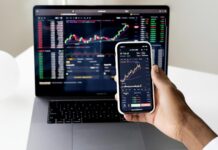The forex market is very volatile and comes with a lot of risks. Beginner forex traders need to have a proper understanding of how the market works.
You achieve this by practicing with a free demo account. You need to seek ways to reduce your trading risks to a minimum before opening a real account.
Risk Management is necessary to prevent you from the horrific consequences associated with careless trading. Most people think that the only way to minimize risk is by using a stop-loss order. However, this isn’t so.
Below, this article discusses the different ways beginner forex traders can manage risk, including the stop-loss order. Read on and discover how to minimize your trading risks.
Avoid Unregulated Brokers
A forex broker is an intermediary between the foreign exchange market and a trader. To trade forex, you must employ the services of a broker. There are numerous brokers available online and it is often difficult to make a choice. Picking a tier 1 regulated broker is the safest. Make sure to read assessments such as an etoro review before making a decision.
Tier 1 regulators include Financial Conduct Authority (FCA) for the UK, Australian Securities and Investments Commission (ASIC) for Australia, Commodities and Futures Trading Commission (CFTC) for the US, and others.
Aim to pick brokers licensed by tier 1 regulators so that you can seek arbitration with the regulatory body when necessary.
Visit the broker’s site and navigate to the bottom of the page where you will find information about regulation. A poorly regulated broker does not only put your money at risk, but could also engage in manipulation of spread, and even hunting of stop loss orders.
According to recent research that ranked best forex brokers based on safety & fees, the most reputed brokers all have their licenses issued by at least 2 top-tier regulators, including the FCA which is a tier-1 regulator. Those brokers without a tier 1 license are generally unsafe or high risk. This goes to show that regulation is very important when choosing a broker.
Beware of brokers licensed by lower-tier regulators from tax haven islands like St Vincent and Grenadines, Belize, etc. Such brokers are more likely to engage in activities that are detrimental to their retail clients. This ranges from conflict of interest, poor customer service to duping clients of their funds.
Stop-Loss Orders, Guaranteed Stop-Loss Orders, Copy Stop-Loss
Firstly, a stop-loss order is a risk management tool used by a trader to buy or sell a stock once a certain price has been reached (the stop price). Stop-loss orders reduce risk whilst trading.
For example, if you purchase Apple shares for $30 and set the stop-loss order at 20% below the entry price, the stop-loss order triggers when the price falls to $24.
Your shares then sell at the current market value. There may be a slight difference between the closing position and stop price due to market volatility.
Secondly, a Guaranteed Stop-Loss Order (GSLO) functions as the regular stop-loss order but guarantees closing your position at your desired stop price regardless of market volatility.
This attracts a premium charge, unlike the stop-loss order which is free. The fees charge only when a GSLO executes. GSLO can be used during high volatile market periods, eliminating slippage.
Thirdly, a Copy Stop Loss (CSL) is used to reduce risk while copying trading. The default CSL is set at 5% of your investment, meaning that you lose 95% of your funds in the event of a loss when you copy another trader’s position. You can adjust the CSL to close the copy at your desired rate.
Use Leverage Sparingly Until You Become an Expert
Leverage provides you with more funds to trade with than what you have in your trading account. When you use leverage, you borrow money from your broker.
The leverage available to a trader depends on the margin level requirements of the broker. A margin is a percentage of money required for you to deposit before opening a trade. Tier 1 regulators have set a general margin level of around 3.3% for their licensed brokers when offering CFD and CFD like options to clients.
For instance, if you want to open a trade worth $100,000 using a margin level of 3.3%, then you need to deposit $3,300 only. The broker provides the remaining $96,700 for you to trade. The leverage ratio for this trade is 30:1.
As a beginner, you can be tempted to use higher leverage like 1:1,000 offered by tier 2 and 3 regulated brokers. This would be to realize greater profits. Bear in mind that when leverage is too high, you are on a slippery slope. The slightest negative market movement can see you lose all your capital and even owing your broker. In the case of a loss, you must refund your broker’s money.
Given the risks associated with the use of high leverage by retail traders, major regulators already imposed restrictions. These restrictions tackled harm to investors trading CFDs as per regulators.
Calculate Risk to Reward Ratio
The risk to reward ratio (R/R ratio) is an assessment showing the possible risks and potential rewards attributable to a trade. This shows how much you are willing to let go of to make profits.
The R/R ratio = (Entry point – Stop price) / (Profit target – Entry point)
For instance, if you intend to buy a stock worth $32 and set a stop-loss order at $28 and a profit target of $34, the R/R ratio is $32- $28 / $34- $32 = 2:1. This means you are risking $2 just to make $1.
Before you begin a trade, it is necessary to calculate the risk to reward ratio. You should set the stop-loss order and profit target at reasonable prices to arrive at a fair R/R ratio. A trade with a higher risk compared to its profit is not worth opening.
Trade Only Major Currency Pairs
Beginner forex traders should trade only with major currency pairs. This is because they are more liquid and represent the larger volume of the forex market. Examples of major currency pairs are EUR/USD, GBP/USD, USD/JPY, and USD/CHF.
Exotic pairs, on the other hand, are sparsely traded currencies. They lack market depth and are highly volatile since they are currencies for developing economies.
If you trade exotic pairs, it is often difficult getting a counterparty when you want to close opened positions. Examples of exotic currencies are the Thai baht, Uruguay peso, and the Iraqi dinar.
If you are copy trading, ensure that your copy trader is trading with the major currency pairs.
Trade During Periods When Liquidity Is High, and Volatility Is Reduced
Liquidity refers to the ease at which you buy or sell securities at a fair price. High liquidity tightens the Bid/Ask spread, making it easy to trade.
There are four trading sessions worldwide from Mondays to Fridays. New York, Tokyo, Sydney, and London trade at different times but can overlap due to time differences.
The best time to trade is during the overlapping sessions, where more than one market opens at the same time, which increases liquidity. U.S/London overlap is the best time to trade because the most popular currencies trade.
The EUR/USD pair covers up to 70% of total trades. Sydney/Tokyo overlap session isn’t as volatile as US/London but still offers opportunities to trade.
You should also watch out for major news before trading and for major economic news during trading. For example, Shanghai eased lockdown restrictions after Covid cases but the Yuan could be affected. This in turn affects the currencies of China’s major trading partners.
It isn’t advisable to trade when the market liquidity is low because you often find it difficult to get a counterparty.
Only Engage in Copy Trading If You Have Sufficient Capital
Copy trading enables you to copy an expert’s trade position. Here, you analyze a trader’s records to see if it is worth emulating.
You should only engage in copy trading if you have sufficient capital. This is because an expert trader often has large capital and if he makes a small loss, this can wipe out your balance.
Therefore, you want to have capital, so you don’t lose all your funds when there is a small loss or increase in volatility. Also, beginner forex traders should copy trades from different experts to reduce risks. Take note that a history of profitability does not guarantee future returns.
Also, you must be able to understand the strategy and risk profiles of the traders you copy.
As a New Trader, Start with Small Accounts
A ‘lot’ is an amount of the currency pair you are buying or selling. There are four variants of lots in forex trading which are the standard, mini, micro and nano.
The Standard, Mini, Micro and Nano lots equal 100,000, 10,000, 1,000 and 100 units of the base currency respectively. Going for larger lots means that you have temptation to use larger leverage. As a beginner, you should start with smaller accounts to minimize your exposure.
Final Thoughts
Beginner forex traders can minimize risks by using different methods and learning about risk management.
Bear in mind that you should not rely on your emotions to make trading decisions. You must study and analyze the market to avoid losses.
Find a Home-Based Business to Start-Up >>> Hundreds of Business Listings.
















































